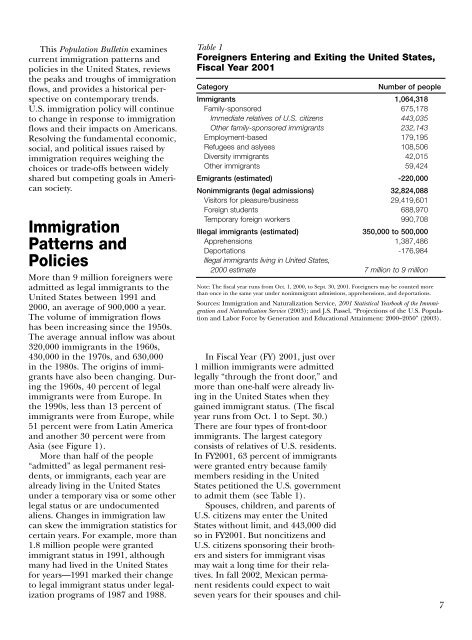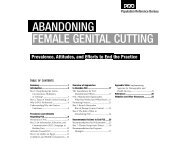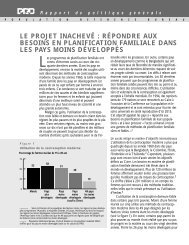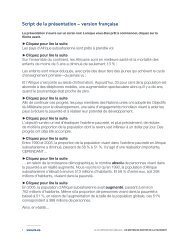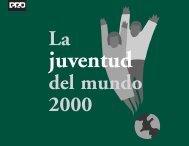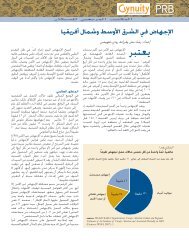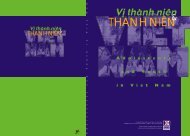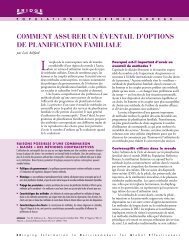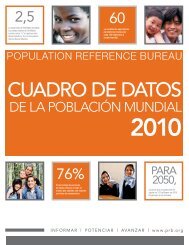Immigration Shaping America - Population Reference Bureau
Immigration Shaping America - Population Reference Bureau
Immigration Shaping America - Population Reference Bureau
You also want an ePaper? Increase the reach of your titles
YUMPU automatically turns print PDFs into web optimized ePapers that Google loves.
This <strong>Population</strong> Bulletin examines<br />
current immigration patterns and<br />
policies in the United States, reviews<br />
the peaks and troughs of immigration<br />
flows, and provides a historical perspective<br />
on contemporary trends.<br />
U.S. immigration policy will continue<br />
to change in response to immigration<br />
flows and their impacts on <strong>America</strong>ns.<br />
Resolving the fundamental economic,<br />
social, and political issues raised by<br />
immigration requires weighing the<br />
choices or trade-offs between widely<br />
shared but competing goals in <strong>America</strong>n<br />
society.<br />
<strong>Immigration</strong><br />
Patterns and<br />
Policies<br />
More than 9 million foreigners were<br />
admitted as legal immigrants to the<br />
United States between 1991 and<br />
2000, an average of 900,000 a year.<br />
The volume of immigration flows<br />
has been increasing since the 1950s.<br />
The average annual inflow was about<br />
320,000 immigrants in the 1960s,<br />
430,000 in the 1970s, and 630,000<br />
in the 1980s. The origins of immigrants<br />
have also been changing. During<br />
the 1960s, 40 percent of legal<br />
immigrants were from Europe. In<br />
the 1990s, less than 13 percent of<br />
immigrants were from Europe, while<br />
51 percent were from Latin <strong>America</strong><br />
and another 30 percent were from<br />
Asia (see Figure 1).<br />
More than half of the people<br />
“admitted” as legal permanent residents,<br />
or immigrants, each year are<br />
already living in the United States<br />
under a temporary visa or some other<br />
legal status or are undocumented<br />
aliens. Changes in immigration law<br />
can skew the immigration statistics for<br />
certain years. For example, more than<br />
1.8 million people were granted<br />
immigrant status in 1991, although<br />
many had lived in the United States<br />
for years—1991 marked their change<br />
to legal immigrant status under legalization<br />
programs of 1987 and 1988.<br />
Table 1<br />
Foreigners Entering and Exiting the United States,<br />
Fiscal Year 2001<br />
Category<br />
Number of people<br />
Immigrants 1,064,318<br />
Family-sponsored 675,178<br />
Immediate relatives of U.S. citizens 443,035<br />
Other family-sponsored immigrants 232,143<br />
Employment-based 179,195<br />
Refugees and aslyees 108,506<br />
Diversity immigrants 42,015<br />
Other immigrants 59,424<br />
Emigrants (estimated) -220,000<br />
Nonimmigrants (legal admissions) 32,824,088<br />
Visitors for pleasure/business 29,419,601<br />
Foreign students 688,970<br />
Temporary foreign workers 990,708<br />
Illegal immigrants (estimated) 350,000 to 500,000<br />
Apprehensions 1,387,486<br />
Deportations -176,984<br />
Illegal immigrants living in United States,<br />
2000 estimate 7 million to 9 million<br />
Note: The fiscal year runs from Oct. 1, 2000, to Sept. 30, 2001. Foreigners may be counted more<br />
than once in the same year under nonimmigrant admissions, apprehensions, and deportations.<br />
Sources: <strong>Immigration</strong> and Naturalization Service, 2001 Statistical Yearbook of the Immmigration<br />
and Naturalization Service (2003); and J.S. Passel, “Projections of the U.S. <strong>Population</strong><br />
and Labor Force by Generation and Educational Attainment: 2000–2050” (2003).<br />
In Fiscal Year (FY) 2001, just over<br />
1 million immigrants were admitted<br />
legally “through the front door,” and<br />
more than one-half were already living<br />
in the United States when they<br />
gained immigrant status. (The fiscal<br />
year runs from Oct. 1 to Sept. 30.)<br />
There are four types of front-door<br />
immigrants. The largest category<br />
consists of relatives of U.S. residents.<br />
In FY2001, 63 percent of immigrants<br />
were granted entry because family<br />
members residing in the United<br />
States petitioned the U.S. government<br />
to admit them (see Table 1).<br />
Spouses, children, and parents of<br />
U.S. citizens may enter the United<br />
States without limit, and 443,000 did<br />
so in FY2001. But noncitizens and<br />
U.S. citizens sponsoring their brothers<br />
and sisters for immigrant visas<br />
may wait a long time for their relatives.<br />
In fall 2002, Mexican permanent<br />
residents could expect to wait<br />
seven years for their spouses and chil-<br />
7


